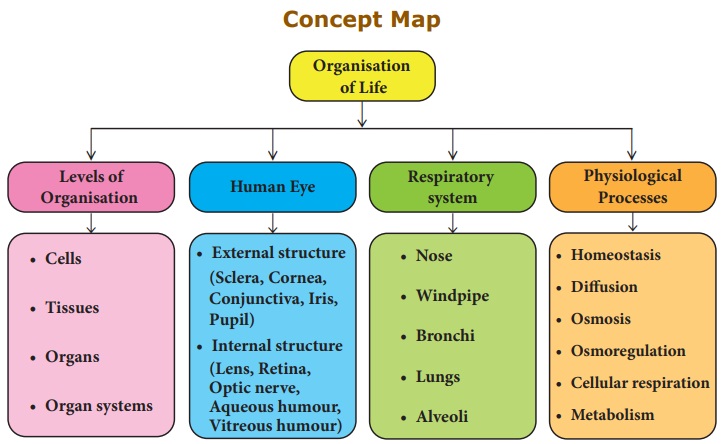Organisation of Life | Chapter 18 | 8th Science - Points to Remember, Glossary, Concept Map | 8th Science : Chapter 18 : Organisation of Life
Chapter: 8th Science : Chapter 18 : Organisation of Life
Points to Remember, Glossary, Concept Map
Points to Remember
• Cell is the basic structural and
functional unit of living organisms. All living organisms are made up of cells.
• Cells vary in shapes and size. The
size of a cell is measured in micrometers (µm).
• Cells are combined together to
form tissues. The tissues are combined together to form organs. Many organs are
combined together to form the organ system.
• The sense organ eye is concerned
with vision.
• Respiration is the process in
which energy is released while food is oxidised. It consists of external
respiration and internal respiration (cellular respiration).
• There are two types of respiration
depending upon the availability of oxygen. They are aerobic respiration and
anaerobic respiration.
• Selective permeability of plasma
membrane enables the cell to maintain homeostasis.
• Diffusion involves movement of
molecules from the region of their higher concentration to the region of their
lower concentration which can occur without a semi permeable membrane.
• Osmosis involves movement of
solvent molecules from the region of their higher
concentration to the region of their
lower concentration which can take place through a semi permeable membrane.
• Homeostasis is the maintenance of
a constant internal environment of the body.
• Metabolism involves release and
utilisation of energy or energy exchange within the organisms. It can be
divided into two categories namely anabolism and catabolism.
• The repeated anabolic and
catabolic reactions in the metabolic process maintain the homeostatic condition
of the body.
GLOSSARY
1.
Alveoli Tiny air sacs of the
lungs which allow for rapid gaseous exchange.
2.
Eukaryotic An
organism having cells each with a distinct nucleus within which the genetic material
is contained.
3.
Organelles Specialized
structures within a cell that perform a specific function.
4.
Micron Small unit of
measurement that measures length which is one thousand of a millimetre.
5.
Haemoglobin Iron
containing red pigment of red blood cells of vertebrates, which gives red colour
to blood.
6.
Prokaryotic Typically
unicellular microorganism that lack a distinct nucleus and membrane bound
organelles.
7.
Diaphragm The muscle that
separates the chest (muscle) cavity from the abdomen.
8.
Pleura Protective covering
of the lungs.
9.
Metabolism The sum of all
chemical reactions by which living organisms sustain their life.
Concept Map

REFERENCE BOOKS
1. The Science of Biology - Raven,
Johnson. McGraw Hill.
2. Histology and Cell Biology -
Kierstenburm
3. Elsevier’s Dictionary of the
Genera of life
4. Cell Biology Organelle Structure
and function.
INTERNET RESOURCES
1. h t t p s : / / s c i e n c i n g .
c o m / l e v e l s - organization-biology-8480388.html
2. http://www.biologyreference.com/Gr-Hi/
History-of-Biology-Cell-Theory-and-Cell-Structure.html
3. http://www.biologyreference.com/A-Ar/
Animalia. html
Related Topics